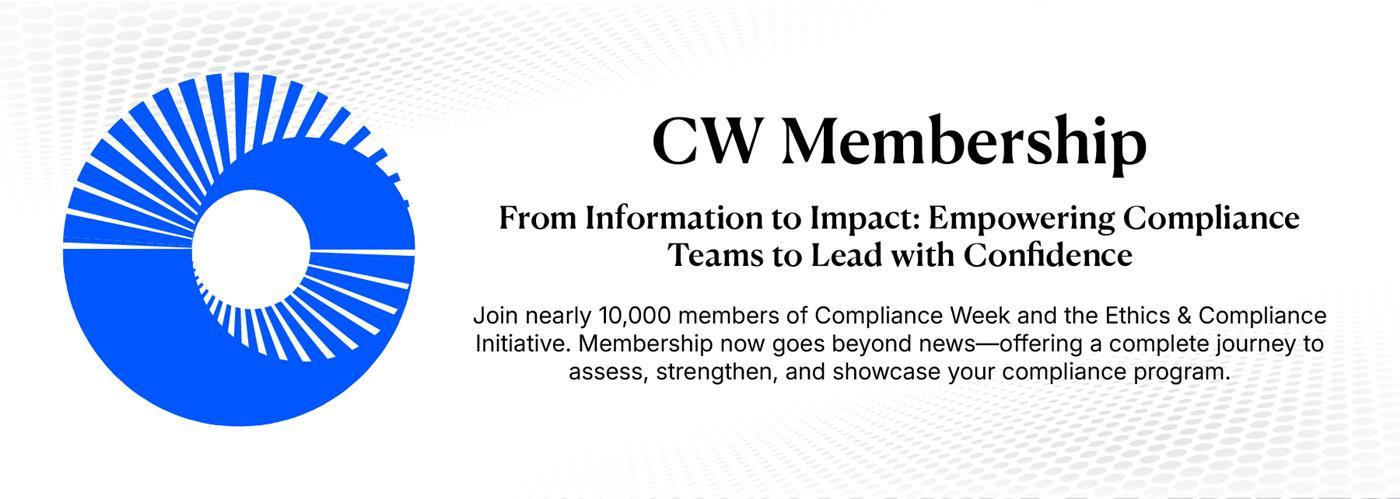- Home
-
News
- Back to parent navigation item
- News
- National Compliance Officer Day 2025
- Accounting & Auditing
- AI
- AML
- Anti-Bribery
- Best Practices
- Boards & Shareholders
- Cryptocurrency and Digital Assets
- Culture
- ESG/Social Responsibility
- Ethics & Culture
- Europe
- Financial Services
- Internal Controls
- Regulatory Enforcement
- Regulatory Policy
- Risk Management
- Sanctions
- Surveys & Benchmarking
- Supply Chain
- Third Party Risk
- Whistleblowers
- Opinion
- Benchmarking
- Certification
- Events
- Research
- Awards
-
CW Connect
- Back to parent navigation item
- CW Connect
- Sign In
- Apply
- Membership
My Compliance Library: ‘The Culture Map’ reminds CCOs context is everything
By  Richard Bistrong2019-09-27T15:06:00
Richard Bistrong2019-09-27T15:06:00

THIS IS MEMBERS-ONLY CONTENT
You are not logged in and do not have access to members-only content.
If you are already a registered user or a member, SIGN IN now.
Related articles
-
 Article
ArticleMy Compliance Library: ‘Can You Hear Me?’ a guide for virtual connections
2021-01-27T18:40:00Z By Richard Bistrong
You might not have thought you needed it, but Nick Morgan’s “Can You Hear Me?” provides some valuable advice for getting the most out of your daily virtual meetings and conversations.
-
 Article
ArticleMy Compliance Library: ‘Gloom to Boom’ a guide for turning risk into opportunity
2020-06-25T17:12:00Z By Richard Bistrong
CW contributor Richard Bistrong shares his thoughts on Dr. Andrea Bonime-Blanc’s book within the context of the DOJ’s most recent compliance guidance and the turbulent times in which we are currently living.
-
 Article
ArticleMy Compliance Library: ‘Crude Intentions’ gets at the why of compliance
2020-04-13T20:40:00Z By Richard Bistrong
A reading of “Crude Intentions” can go a long way toward educating those who work in high-risk regions as to the ramification of their misguided decisions.
More from My Compliance Library
-
 Article
ArticleMy Compliance Library: ‘The Behavioral Code’ explores tension between code and conduct
2022-02-23T13:00:00Z By Richard Bistrong
Benjamin van Rooij and Adam Fine’s book is an exposition on shaping laws and codes to “human and organizational behavior” that lends to the discussion on how behavioral science can inform ethics and compliance programs.
-
 Article
ArticleMy Compliance Library: ‘The Long Game’ offers timely look at long-term career planning
2021-12-01T14:00:00Z By Richard Bistrong
Dorie Clark’s best-selling book “The Long Game” challenges us to ponder what it would look like to “discover our own definition of success” at a time when more professionals than ever are quitting their jobs in search of positive change.
-
 Article
ArticleMy Compliance Library: ‘What on Earth Can Go Wrong’ explores managing risk through global lens
2021-08-27T14:31:00Z By Richard Bistrong
In “What on Earth Can Go Wrong,” Richard Fenning shares what he learned over the course of nearly three decades exploring the world through the eyes of a risk management expert.
- Terms and Conditions
- Privacy Policy
- Do Not Sell My Info
- © 2025 Compliance Week
Site powered by Webvision Cloud






